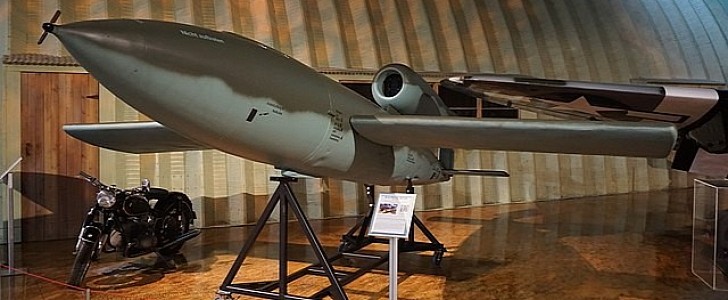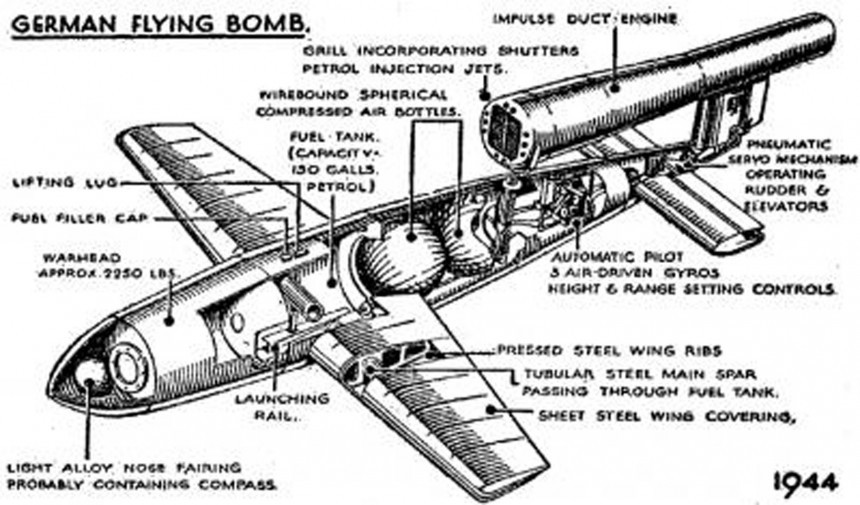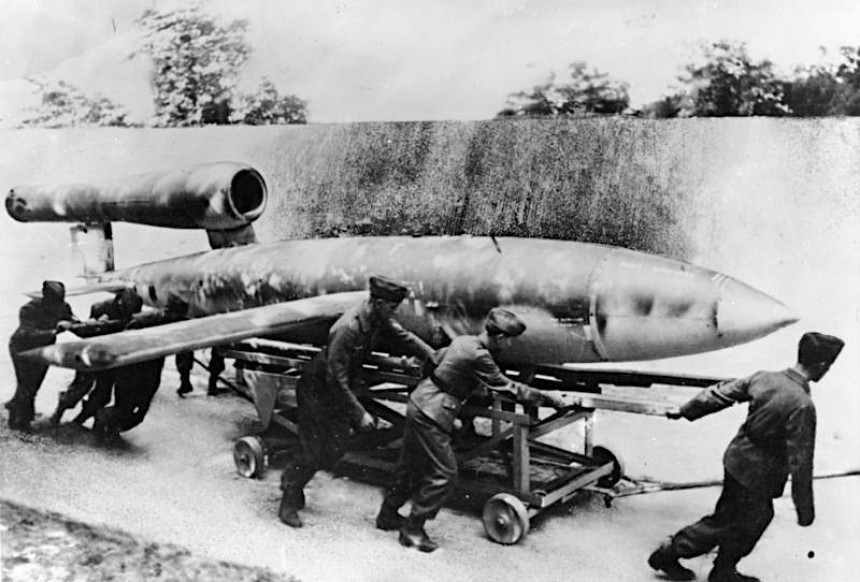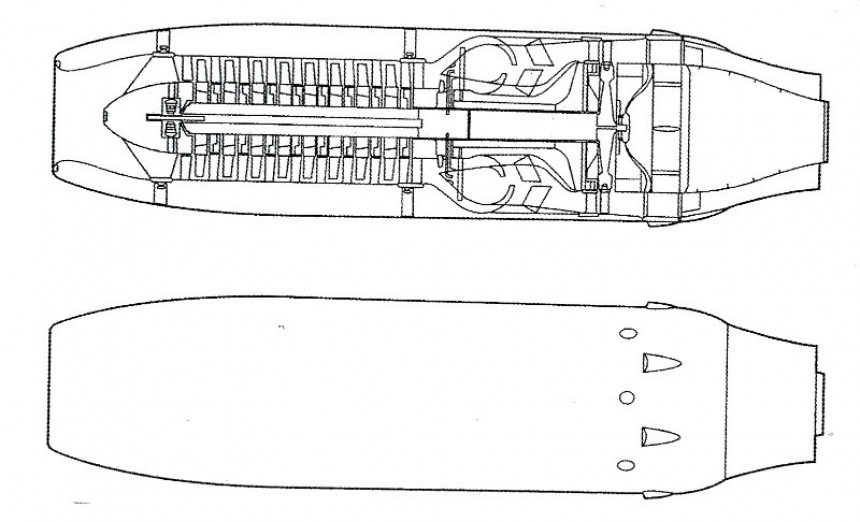Buzz Bomb, Doodlebug, and Vengeance Weapon. These are some of the names attributed to one of the Second World War's most fascinating aeronautical projects.
Not for its contribution to the advancement of aviation, but from the sheer amounts of terror it struck into the hearts of Allied nations. A weapon the Germans called V-1. As much as he's known for his work of building rear-engined sports cars later in life, the V-1 Flying Bomb is the kind of project Ferdinand Porsche was contracted to contribute to by the German military.
Legend says you could tell a V-1 flying bomb was incoming by the distinct sporadic hum of its rudimentary jet fuel-powered pulse engine. The engine mimicked the sounds of a large winged insect, at least based upon eye-witness reports from the time.
Only shortly after British citizens had gotten over the initial Battle of Britain campaign, the streets of London were vulnerable to enemy attacks once more. This time, the Germans didn't even need to risk the life of a pilot to make it happen. From June of 1944 until the following spring, V-1s and other weapons under the "Vengeance" category bombarded Allied positions in France, the United Kingdom, and elsewhere in Europe.
Its rudimentary jet engine technology was a part of a much larger program within the German Luftwaffe to create the most advanced jet-engined fighters the world had ever seen to that point. The V-weapon program also included the V-2 Ballistic missile.
A rudimentary gyrocompass controlled autopilot system, another tech feature developed especially for the V-1. Similar systems would form the groundwork for Russian and American autopilots in fighters that made their debuts soon after the Second World War.
British and American fighters shot down quite a few Buzz Bombs, but some still slipped past defenses and wreaked havoc across the English Channel in Britain, a feat once thought impossible only a handful of years before the V-1's maiden flight.
The German jet program was overseen by the Commander in Chief of the Luftwaffe Hermann Göring. A former First World War fighter ace that'd been embattled with a crippling combination of an eating disorder and deeply seeded addiction to morphine during his time as a high-ranking German commander.
Some historians believe that Göring may have written blank checks to German engineers who promised the most revolutionary and novel ideas. Investments in designs like the V-1, but also the Me-262, Ho-229, and He-163 that are thought to be the result of Göring's folly.
Such weapons were no doubt also be powerful tools of propaganda. Tools that the German Minister of Public Enlightenment and Propaganda Joeseph Goebels would no doubt sensationalize and over exaggerate to no end in the name of making the German war machine viewed favorably.
Propaganda pieces touting the superiority of Luftwaffe aircraft over Allied ones were rife and flourishing in the German Reich at this time. If the V-1 is anything to go by, it's propaganda that wasn't just all talk. And in the middle of all this international quagmire is none other than Old Man Porsche himself.
His assignment in the V-1 program was to help develop a new turbojet engine that could give the V-1 a performance edge over the original pulse-jet design. Considering the original V-1 could cruise at 400 mph (640 kph), it must have been quite the speed boost.
Porsche was a brilliant engineer. His other military accomplishments include the Tiger I tank prototype and the Elefant (Ferdinand) tank destroyer. Two competent and sophisticated weapons platforms that were marred by Russian anti-tank tactics perpetually throughout the war in Europe.
By spring 1945, the blueprints for the Porsche 109-005 turbojet engine were ready to be submitted. But right around this time, the German war machine finally collapsed. The end of the Third Reich spelled the permanent end of Ferdinand Porsche's career as a military contractor.
Porsche's jet engine design never found its way onto a flying bomb before the end of the war. Good news for the citizens of Europe at the time, such a weapon would have certainly been terrifying. Based on one rudimentary sketch up of the design that does exist.
It appears to be similar in design to other German jet engines under study at this time, like the Junkers Jumo 004 and the BMW 003. But what the German Army desired most out of Ferdinand Porsche's engine design was an ease of use and maintenance that was simply wasn't satisfactory enough in some competing German jet engine systems.
Ease and expense of production were also of utmost priority as Germany prepared for the potential of jet on jet combat in a hypothetical extended war.
We'll never know for certain just how destructive Porsche's jet engine could have made the infamous German V-1. But if we had to take an educated guess, it would make the version we saw in reality seem like glorified target practice.
Perhaps it's best the end of the war allowed Old Man Porsche to engage in other, more automotive-related pursuits. Which he was much happier and more suited to do.
Legend says you could tell a V-1 flying bomb was incoming by the distinct sporadic hum of its rudimentary jet fuel-powered pulse engine. The engine mimicked the sounds of a large winged insect, at least based upon eye-witness reports from the time.
Only shortly after British citizens had gotten over the initial Battle of Britain campaign, the streets of London were vulnerable to enemy attacks once more. This time, the Germans didn't even need to risk the life of a pilot to make it happen. From June of 1944 until the following spring, V-1s and other weapons under the "Vengeance" category bombarded Allied positions in France, the United Kingdom, and elsewhere in Europe.
Its rudimentary jet engine technology was a part of a much larger program within the German Luftwaffe to create the most advanced jet-engined fighters the world had ever seen to that point. The V-weapon program also included the V-2 Ballistic missile.
The simplicity combined with the elegance of the design evokes the ethos of something more akin to a brilliant technology demonstrator instead of a weapon that killed thousands of Allied troops and civilians. Like it actually was, on the battlefields in Europe.
A rudimentary gyrocompass controlled autopilot system, another tech feature developed especially for the V-1. Similar systems would form the groundwork for Russian and American autopilots in fighters that made their debuts soon after the Second World War.
British and American fighters shot down quite a few Buzz Bombs, but some still slipped past defenses and wreaked havoc across the English Channel in Britain, a feat once thought impossible only a handful of years before the V-1's maiden flight.
The German jet program was overseen by the Commander in Chief of the Luftwaffe Hermann Göring. A former First World War fighter ace that'd been embattled with a crippling combination of an eating disorder and deeply seeded addiction to morphine during his time as a high-ranking German commander.
Such weapons were no doubt also be powerful tools of propaganda. Tools that the German Minister of Public Enlightenment and Propaganda Joeseph Goebels would no doubt sensationalize and over exaggerate to no end in the name of making the German war machine viewed favorably.
Propaganda pieces touting the superiority of Luftwaffe aircraft over Allied ones were rife and flourishing in the German Reich at this time. If the V-1 is anything to go by, it's propaganda that wasn't just all talk. And in the middle of all this international quagmire is none other than Old Man Porsche himself.
His assignment in the V-1 program was to help develop a new turbojet engine that could give the V-1 a performance edge over the original pulse-jet design. Considering the original V-1 could cruise at 400 mph (640 kph), it must have been quite the speed boost.
By spring 1945, the blueprints for the Porsche 109-005 turbojet engine were ready to be submitted. But right around this time, the German war machine finally collapsed. The end of the Third Reich spelled the permanent end of Ferdinand Porsche's career as a military contractor.
Porsche's jet engine design never found its way onto a flying bomb before the end of the war. Good news for the citizens of Europe at the time, such a weapon would have certainly been terrifying. Based on one rudimentary sketch up of the design that does exist.
It appears to be similar in design to other German jet engines under study at this time, like the Junkers Jumo 004 and the BMW 003. But what the German Army desired most out of Ferdinand Porsche's engine design was an ease of use and maintenance that was simply wasn't satisfactory enough in some competing German jet engine systems.
We'll never know for certain just how destructive Porsche's jet engine could have made the infamous German V-1. But if we had to take an educated guess, it would make the version we saw in reality seem like glorified target practice.
Perhaps it's best the end of the war allowed Old Man Porsche to engage in other, more automotive-related pursuits. Which he was much happier and more suited to do.












